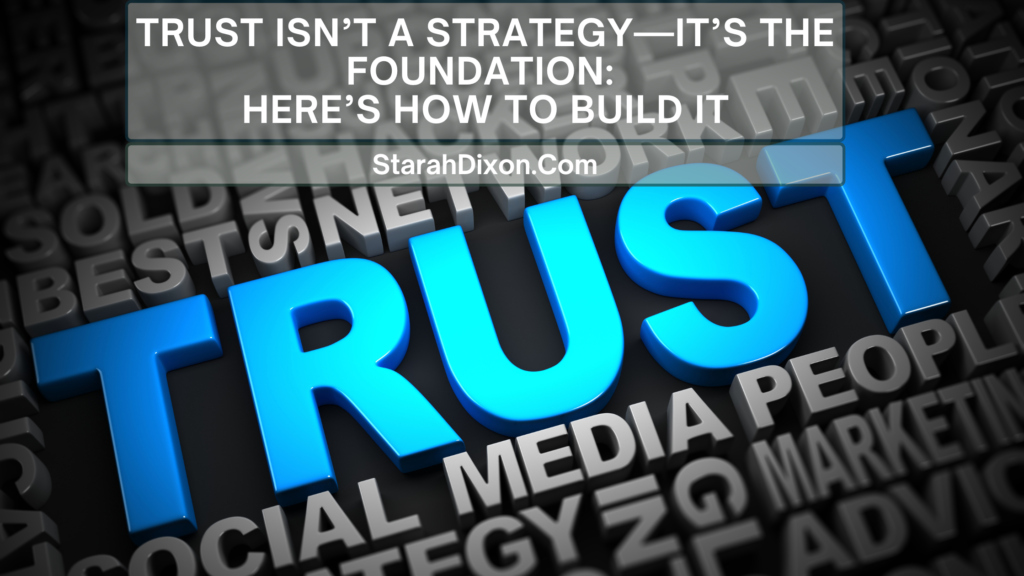In a world where digital noise is louder than ever, building a brand that people actually trust isn’t just important-it’s everything. As leaders, we’re constantly told to scale fast, grow faster, and do whatever it takes to stand out. But here’s the truth: trust is what makes a brand sustainable. And spoiler alert: it doesn’t come from gimmicks, quick wins, or perfect aesthetics. It comes from consistency, honesty, and a real connection with your audience.
This month on Authentic Ambitions, we’re exploring the theme: “How Leaders Can Build a Brand on Trust.” In this article, I’m diving deep into what that really looks like-from the often overlooked basics to some unpopular (but necessary) truths. So let’s break it down.
1. Ask for Real Reviews (Yes, Even If It Takes Time)
Social proof sells. But fake reviews ruin credibility. It can be tempting to create your own testimonials or ask friends to write something polished and glowing, but that shortcut erodes trust over time. Instead:
- Follow up with real customers after they’ve used your product or service.
- Make it easy with a direct link, a QR code, or a one-click review system.
- Offer a genuine thank you (not a bribe) for their time.
To be honest, this is where I initially started off a little wonky with Mitsooz. I focused on how I would present the business and not necessarily on how reviews help people who don’t know about you actually get to. So, I started strongly incorporating this into the business. I even provide review prompts for people receiving Mitsooz packages. Whether the feedback is good or bad, I want people to know the ins and outs and opinions of the product.
And one thing I want to make sure people-especially first-time entrepreneurs-understand is this: if you receive a negative review on a product or service, take it as an opportunity to learn the “why.” Change what needs to be changed, or recognize that the issue might be something out of your control. Also, though easier said than done (especially the first time), don’t take the negative review as a reflection of you. The superpower is in using it to your advantage.
You don’t need hundreds of reviews overnight. You need a handful of real ones that reflect the quality and heart behind what you offer.
That said, I also understand that some businesses pull reviews from the same product sold on different platforms or websites. And truthfully, I believe that’s okay-as long as you’re transparent about it. If a review came from an external marketplace or third-party platform, mark it clearly. Labeling the source shows honesty and builds trust while still allowing you to showcase feedback on your product. Transparency matters-and in many cases, this helps businesses grow.
2. Be Consistent in What You Offer
Nothing builds trust like delivering exactly what someone paid for. And nothing breaks it faster than inconsistency.
That includes:
- Branded packaging that reflects care and professionalism
- Shipping timelines that match what you promised
- Product quality that aligns with your photos and descriptions
Your customer experience is your brand in action. When people know what to expect and consistently receive it, you’re building a reputation without even saying a word. And this is also where you set your minimum bar. When you meet expectations, you’ve earned the right to stay in the conversation. But when you exceed them? That’s when you become memorable.
Now I know-custom packaging and premium touches can get expensive. But here’s the thing: you can elevate the experience without breaking the bank. Instead of designing a custom box, start by customizing your packaging tape. That small detail still gives your customer that “oooh… ahhhh” moment. For service providers, consider including a beautifully designed bonus PDF, checklist, or exclusive video training. People love to feel included and informed-not surprised and swiped at-especially when their money is involved.
3. Stay Present on Social (Even When It’s Quiet)
Likes do not equal loyalty. You might have 10,000 followers and no sales, or 100 followers and a booked-out calendar. The key is this:
Show up anyway.
Posting regularly tells your audience:
- You’re still in business
- You’re invested in what you do
- You’re not just here for the attention-you’re here to serve
This is something I actively work on-whether it’s for Authentic Ambitions, Mitsooz, or my personal platform at StarahDixon.com. Truthfully, I’ve never been a “social media person” because I like to move through life in the present. But I had to admit: opportunities are missed when no one online knows what’s happening. Especially when access to your business is online.
So now, I move with intention. For me, the Monday/Wednesday/Friday posting schedule works well, and I literally set alarms on my phone to make it happen. It’s about making the schedule work for you, not the other way around.
And if you’re feeling overwhelmed, Hire a freelancer. Thank goodness for sites like Fiverr, Upwork, and even growing your own team when you’re ready. You can also schedule posts ahead of time using tools like Metricool or Later. There’s no shame in simplifying. Staying visible doesn’t mean being online 24/7-it means being present with purpose.
4. Build a Referral Culture That Feels Personal
Everyone knows someone. Even if your service isn’t a match for someone right now, they might have a friend, coworker, or client who could benefit from what you do.
Offer a referral system that feels less like a transaction and more like a connection:
- Ask, “How did you hear about us?” on forms
- Thank referees with a shoutout, handwritten note, or exclusive perk
- Let them feel seen-and valued-for their role in your growth
For e-commerce stores, you can even set up programs where customers refer your business directly. And this applies just as well to service-based businesses too. If you have a website, make sure there are easy ways for people to share your offerings-bonus points if you ask them to share on social media.
Think of it as virtual word-of-mouth, which remains one of the most powerful forms of marketing-and honestly, the biggest form of flattery. The goal here is simple: let people advocate for you.
You don’t always need affiliate links or discount codes. Sometimes, just naming the referee makes the impact. And in every case, this is yet another layer of social proof that works in your favor.
5. Handle Problems With Care (This Is Where Trust Is Truly Built)
Things go wrong. Packages get lost. Services get miscommunicated. Products arrive damaged. Trust isn’t lost when there’s an issue-it’s lost when people feel abandoned during it.
And to be honest, I truly believe that the best time for things to go wrong is at the start of your business-when everything is still fresh. Why? Because it gives you the chance to figure out the kinks early and make your systems better right off the bat, before your customer base grows larger and the stakes feel higher.
Will it feel overwhelming the first few times? Of course. But imagine that same issue happening with dozens-or hundreds-of customers. Getting ahead of those breakdowns is what turns a good brand into a resilient one.
This is exactly how I learned to file claims with USPS for broken items and built a smooth return shipping process. One of the biggest hurdles for me early on was simply learning how to ship properly. Will more issues come up down the line? Absolutely. But like I said at the beginning of this point: trust isn’t lost when there’s an issue-it’s lost when people feel abandoned during it.
Here’s how to handle the negative moments:
DO:
- Respond quickly and clearly
- Apologize without defensiveness
- Offer a solution up front
- Follow up to ensure the resolution felt good
DON’T:
- Ignore or delete public complaints
- Blame the customer
- Overpromise and underdeliver on fixing the issue
Example: If someone receives the wrong item, don’t just say “Sorry about that.” Say, “We’re truly sorry this happened. We’ve shipped the correct item and included a small thank you for your patience. Please let us know once it arrives.”
6. Let People Opt Out Without Guilt
If someone decides your product, offer, or email list isn’t for them-let them go with grace. That, too, builds trust.
Avoid pushy language like:
- “Are you sure you want to miss out?”
- “But this is exactly what you need.”
That second one might sound familiar-it’s the kind of messaging many women encounter all too often in online spaces. It’s subtle, but it can feel emotionally manipulative, especially when trust is still in its early stages.
Instead of pushing, offer an option that balances clarity and care. One powerful approach is to offer a limited-time discount to create a natural sense of urgency-while also reassuring your audience that you’ll still be there after the offer expires. It’s a healthy FOMO nudge that works without making anyone feel cornered.
You can also follow up with potential customers in a thoughtful, non-invasive way. Send clear next steps. Check in once or twice within a reasonable window. And if they’re not ready to purchase, consider inviting them to join your newsletter instead. That way, they can stay in the loop with your business and see your consistency over time-on their own terms. It’s not about pestering-it’s about staying present. Sometimes, it’s not a hard “no”-it’s just “not right now.”
The key? Be assertive, not aggressive:
- “Here’s everything you need if and when you’re ready.”
- “Just checking in-if now isn’t the time, we completely understand.”
- “No rush, just here when you need us.”
People will always remember how you made them feel when they weren’t ready to buy. Honor their space, and you just might earn their trust enough for them to return-on their terms.
7. Personalize the Brand Experience
People want to feel like they matter. It doesn’t require grand gestures-just thoughtful ones:
- Add a first name to your email subject lines
- Include a handwritten thank-you in a package
- Remember returning customers and treat them like insiders
That small effort goes a long way. Especially in a world full of automation.
Tysheda and I have talked about this at length-how one thing we absolutely don’t subscribe to in our businesses is that “you’re just a transaction” feeling. Where someone purchases a product or service and then… crickets. No follow-up. No warmth. Just silence.
That’s not how trust is built.
It’s important to be genuinely grateful for the people who are helping keep your business alive and growing. They are literally the reason you’re here. So go the extra step to show appreciation. Make the experience feel personal and intentional, because it is. And when people feel seen and appreciated, they come back-not just because of what you offer, but because of how you made them feel along the way.
8. Lead With Your Why
People don’t just buy what you sell. They buy why you sell it.
Let your values be loud and clear:
- Share what you believe in
- Talk about why you started
- Highlight who you serve and what drives you
But here’s something that’s often overlooked: your “why” isn’t just for your customers-it’s for you too. It serves as an anchor, especially on the tough days when things feel uncertain or overwhelming. Repeating your purpose keeps you grounded. It reminds you of the point. It re-centers the mission when the pressure or comparison tries to creep in.
When both you and your audience are aligned on your why, trust becomes a shared experience. It’s not just a message-it’s a mirror. Repetition matters here. The more you say it, the more it sticks-with them, and with you.
A Note on the Process of Building Trust
Here’s what no one wants to admit: trust takes time.
You can do all the right things and still feel like no one’s noticing. But don’t rush the process. As the saying goes:
“It takes a long time to build trust-and only a moment to destroy it.”
Show up. Be honest. Deliver well. Handle setbacks with grace. That’s the formula. And yes, it works.
All in All: Trust Is the Foundation, Not a Feature
Whether you’re a startup founder, creative entrepreneur, or corporate executive, trust isn’t a marketing strategy. It’s your brand’s backbone. When people trust you, they buy again. They refer you. They root for you.
So lead with it.
If you want to dive deeper into this conversation, watch our latest episode of Authentic Ambitions, where we unpack this month’s theme: “How Leaders Can Build a Brand on Trust.”
We go beyond strategy and get real about what it means to grow with integrity.
You can catch it on YouTube or follow @AuthenticAmbitionsGlobal on Instagram to stay updated on future episodes.
Because the most powerful brand you can build is one that people believe in-even when no one’s watching.



